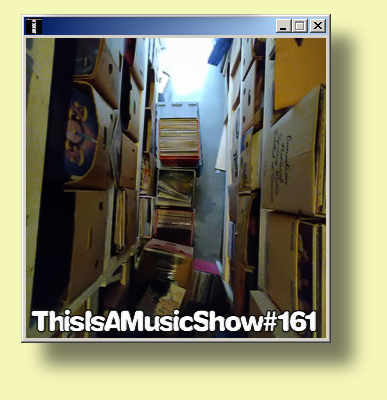http://www.rhci-online.net/radiogram/radiogram.htm

http://www.rhci-online.net/radiogram/radiogram.htm

RSID: <<2022-04-14T23:31Z MFSK-32 @ 9265000+1500>>
Welcome to program 252 of Shortwave Radiogram.
I'm Kim Andrew Elliott in Arlington, Virginia USA.
Here is the lineup for today's program, in MFSK modes as noted:
1:34 MFSK32: Program preview (now)
2:41 MFSK32: Surprising temperature swings on Neptune*
7:40 MFSK64: Fiber-optic cables through water pipes
12:07 MFSK64: This week's images*
28.10 MFSK32: Closing announcements
* with image(s)
Please send reception reports to radiogram@verizon.net
And visit http://swradiogram.net
We're on Twitter now: @SWRadiogram
From Science News:
New thermal maps of Neptune reveal surprising temperature swings
By Liz Kruesi
April 11, 2022
Neptune's atmospheric temperature is on an unexpected
roller-coaster ride, and it could take decades for scientists to
piece together what's happening at the distant planet.
The ice giant's global temperature dropped about 8 degrees
Celsius between 2003 and 2012 at the start of Neptune's summer,
researchers report April 11 in Planetary Sciences Journal. Then
from 2018 to 2020, thermal images show that the planet's south
pole brightened dramatically, indicating a spike of 11 degrees C.
Naomi Rowe-Gurney, a planetary scientist at NASA Goddard Space
Flight Center in Greenbelt, Md., and colleagues looked at 17
years of mid-infrared data from ground-based telescopes and the
no-longer-functioning Spitzer Space Telescope. The researchers
used infrared light to pierce Neptune's top cloud layer and peer
at its stratosphere, where the planet's atmospheric chemistry
comes into view.
Each Neptune year lasts 165 Earth years, so the time period
analyzed — from 2003 to 2020 — is essentially equivalent to five
weeks on Earth. The wildest temperature shift occurred from 2018
to 2020, when the atmospheric temperature at Neptune's south pole
rose from –121° C to –110° C.
"We weren't expecting any seasonal changes to happen in this
short time period, because we're not even seeing a full season,"
says Rowe-Gurney. "It's all very strange and interesting."
The researchers don't yet know what's causing the temperature
changes. The sun's ultraviolet rays break up methane molecules in
the stratosphere, so that chemistry or even the sun's activity
cycle could be a trigger. Nailing down specifics requires more
observations. "We need to keep observing over the next 20 years
to see a full season and see if something else changes," says
Rowe-Gurney.
https://www.sciencenews.org/article/neptune-temperature-atmosphere-new-thermal-maps
See also:
https://phys.org/news/2022-04-astronomers-capture-neptune-temperatures.html
Image: Voyager 2 captured this portrait of Neptune when the NASA
probe flew by the ice giant in 1989. ...
Sending Pic:202x114C;

Shortwave Radiogram now changes to MFSK64 ...
RSID: <<2022-04-14T23:38Z
MFSK-64 @
9265000+1500>>
This is Shortwave Radiogram in MFSK64
Please send your reception report to
radiogram@verizon.net
From TechXplore:
Trial of high-speed broadband delivered through water pipes
by University of Strathclyde, Glasgow
April 8, 2022
Fast broadband will run through water pipes in parts of South
Yorkshire as part of plans to get better internet access to
people quicker.
New proposals to accelerate the rollout of broadband without
digging up roads would see fiber-optic cables deployed through 17
kilometers of live drinking water mains between Barnsley and
Penistone in the government technology trial.
Broadband companies could then tap into the network to deliver
gigabit-capable connections to an estimated 8,500 homes and
businesses along the route, helping to level up hard-to-reach
communities.
The network will also be used to set up 5G masts to bring fast
and reliable wireless broadband to hard-to-reach communities
where wired solutions are too expensive to deliver commercially.
The first trial of its kind in the UK, it will also explore how
fiber can help the water industry detect leaks, operate more
efficiently and lower the carbon cost of drinking water.
The University of Strathclyde will be installing a private 5G
network at two remote locations in Yorkshire and will provide
backhaul, the links which support the network. The project,
funded by the UK Government's Department of Digital Culture,
Media and Sport (DCMS), is led by Yorkshire Water and also
involves engineering company Arcadis.
Civil works, in particular installing new ducts and poles, can
make up as much as four-fifths of the costs to industry of
building new gigabit-capable broadband networks. The Fiber in
Water scheme will demonstrate what could be a greener, quicker
and more cost-effective way of connecting fiber optic cables to
homes, businesses and mobile masts, without the disruption caused
by digging up roads and land.
The technology being deployed during the trials has been approved
by the Drinking Water Inspectorate (DWI). The DWI requires
rigorous testing ahead of approving any products and the
processes that introduce them into drinking water pipes, and
fiber has already been deployed in water pipes in other countries
such as Spain.
The trials will last for up to two years and, if successful, the
technology could be operational in networks from 2024 onwards.
Principal and Vice Chancellor of the University of Strathclyde,
Professor Sir Jim McDonald, said: "The University is delighted to
be a partner in this project which will enable rural connectivity
for communities, as well as providing essential connectivity
support for utilities and their sensing, control and security
requirements.
"At Strathclyde, our StrathSDR communications team have
participated in a number of very successful rural connectivity 5G
projects with DCMS support, and we are also the host of the
Scotland 5G Centre, who we have worked with to create 5G private
networks in remote and rural locations.
"The exciting outputs of this highly innovative project really do
bring new and significant opportunities to improve connectivity
in remote and rural locations in a most cost-effective and
innovative way for the UK and internationally."
Digital Infrastructure Minister Julia Lopez said: "Digging up
roads and land is one of the biggest obstacles to rolling out
faster broadband, so we're exploring how we can make use of the
existing water network to accelerate deployment and help detect
and minimize water leaks.
"We're committed to getting homes and businesses across the
country connected to better broadband and this cutting-edge
project is an exciting example of the bold measures this
government is leading on to level up communities with the very
best digital connectivity."
The first phase of the project launching today will focus on the
legal and safety aspects of this innovative solution, and ensure
that combining clean water and telecoms services in a single
pipeline is safe, secure and commercially viable before any
technology is actually installed.
If successful, the project could be replicated in other parts of
the country and could turbocharge the government's £5 billion
Project Gigabit—the biggest broadband roll out in British history
funding top-of-the-range gigabit connections for millions of
rural homes and businesses that would otherwise be left out of
commercial deployment due to the higher costs of connection.
Yorkshire and Lincolnshire have more than 300,000 rural homes and
businesses in line for an upgrade, including 56,800 premises in
South Yorkshire.
Gigabit-capable broadband coverage has rocketed in the UK from
less than 6% in 2019 to more than 66% following government
measures to stimulate commercial investment from broadband
companies and bust barriers to roll out. In the UK 20 percent of
water put into public supply is wasted due to leaks every day.
With current technology, it can be difficult for water companies
to quickly identify the exact location of a leak and carry out a
repair.
Sam Bright, Innovation Programme Manager at Yorkshire Water said:
"We are very pleased that the Government is supporting the
development of the Fiber in Water solution which can reduce the
environmental impact and day-to-day disruptions that can be
caused by both water and telecoms companies' activities.
"The technology for fiber in water has significantly progressed
in recent years and this project will now enable us to fully
develop its potential to help improve access to better broadband
in hard-to-reach areas and further reduce leakage on our
networks."
https://techxplore.com/news/2022-04-trial-high-speed-broadband-pipes.html
This is Shortwave Radiogram in MFSK64
Please send your reception report to
radiogram@verizon.net
This week's images ...
Our propagation indicator is yellow and purple.
https://bit.ly/3vgsbPN ...
Sending Pic:202x102C;

Molten iron at the 'Siempelkamp' cast iron foundry in Krefeld,
Germany.
https://reut.rs/37jowJ9 ...
Sending Pic:200x150C;
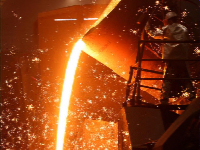
A Tystie (black guillemot), coming in at the New Pier, Papa
Westray, Orkney, Scotland.
https://bbc.in/3xs4F5i ...
Sending Pic:176x205C;

The bus stop near Salen on the Ardnamurchan Peninsula, Scotland.
https://bbc.in/3xs4F5i ...
Sending Pic:157x213C;

Crew practice on the Anacostia River in Washington DC, April 13.
https://bit.ly/3uGxCIO ...
Sending Pic:212x138C;

Tulips near the Tidal Basin in Washington DC, April 8.
https://bit.ly/37j3haq ...
Sending Pic:209x128C;

Tulips near the Mall in Washington DC.
https://wapo.st/3vhwY3J
...
Sending Pic:206x135C;

The colors of the Ukrainian flag illuminate the George Washington
Masonic National Memorial in Alexandria, Virginia.
https://wapo.st/3KL8iqA ...
Sending Pic:153x208C;
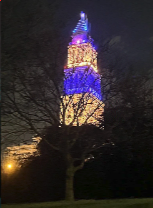
Our painting of the week is "Easter Lily (Lilium longiflorum)" by
Barbara Ann Robertson.
https://bit.ly/3JHmyzl ...
Sending Pic:160x202C;

Shortwave Radiogram returns to MFSK32 ...
RSID: <<2022-04-14T23:58Z MFSK-32 @ 9265000+1500>>
This is Shortwave Radiogram in MFSK32 ...
Shortwave Radiogram is transmitted
by:
WRMI, Radio Miami International, wrmi.net
and
WINB Shortwave, winb.com
Please send reception reports to
radiogram@verizon.net
And visit http://swradiogram.net
Twitter:
@SWRadiogram or twitter.com/swradiogram
I'm Kim Elliott. Please join us for the next Shortwave
Radiogram.
http://www.rhci-online.net/radiogram/radiogram.htm
|
QTH: |
D-06193 Petersberg (Germany/Germania) |
|
|
Ant.: |
Dipol for 40m-Band & Boomerang Antenna 11m-Band |
|
|
RX for RF: |
FRG-100B + IF-mixer & ICOM IC-R75 + IF-mixer |
|
|
Software IF: |
con STUDIO1 - Software italiano per SDR [S-AM-USB/LSB] + beta 11 Version 2.80 (August 21, 2018) - for scheduled IF-recording |
|
|
Software AF: |
Fldigi-4.0.18 + flmsg-4.0.7 images-fldigifiles on homedrive.lnk |
|
|
OS: |
German XP-SP3 with support for asian languages |
German W7 32bit + 64bit |
|
PC: |
MEDION Titanium 8008 (since 2003) [ P4 - 2,6 GHz] |
MSI-CR70-2MP345W7 (since2014) [i5 -P3560 ( 2 x 2,6GHz) ] |
http://wiki.radioreference.com/index.php/Decoding_the_SW_Radiogram_Broadcasts
https://www.qsl.net/ve7vv/Files/Digital%20Modes.pdf
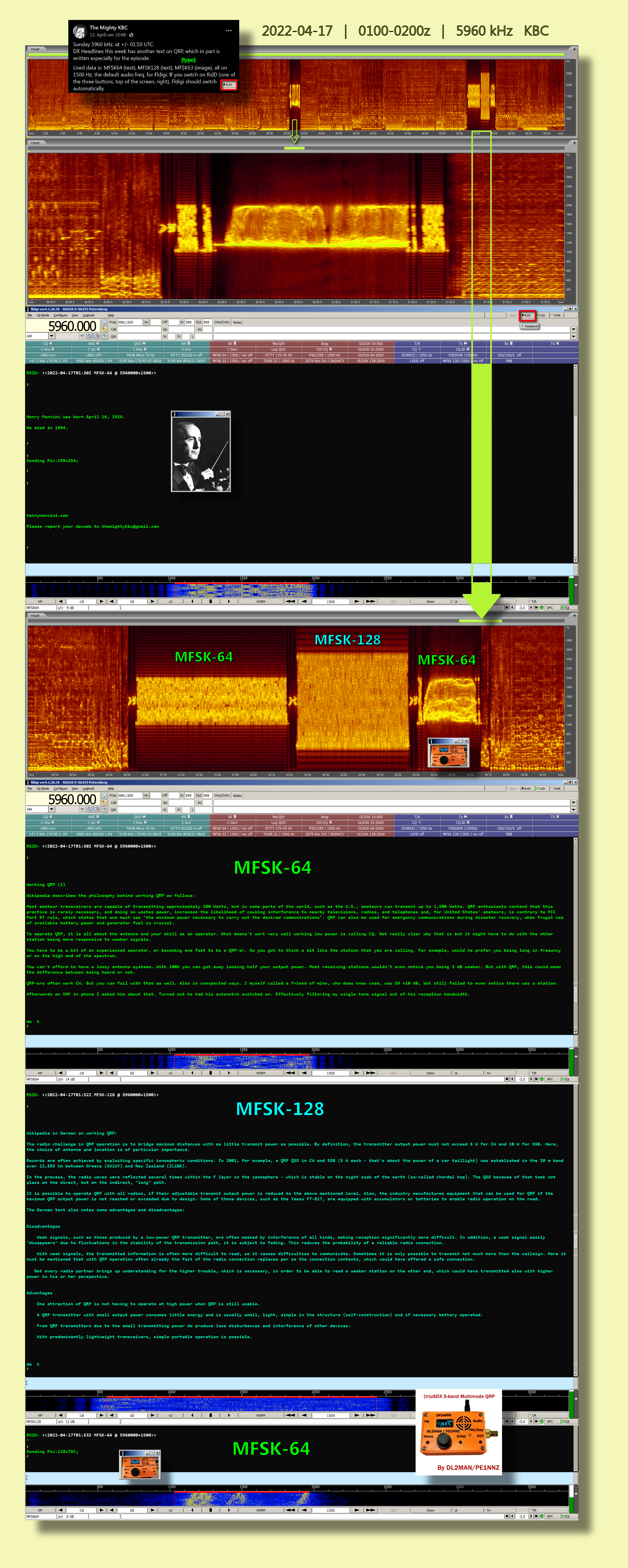
RSID: <<2022-04-17T01:30Z
MFSK-64 @
5960000+1500>>
Henry Mancini was born April 16, 1924.
He died in 1994.
Sending Pic:199x254;

henrymancini.com
Please report your decode to
themightykbc@gmail.com
RSID: <<2022-04-17T01:50Z
MFSK-64 @
5960000+1500>>
Working QRP (2)
Wikipedia describes the philosophy behind working QRP as follows:
Most amateur transceivers are capable of transmitting approximately 100 Watts,
but in some parts of the world, such as the U.S., amateurs can transmit up to
1,500 Watts. QRP enthusiasts contend that this
practice is rarely necessary, and doing so wastes power, increases the
likelihood of causing interference to nearby televisions, radios, and telephones
and, for United States' amateurs, is contrary to FCC
Part 97 rule, which states that one must use "the minimum power necessary to
carry out the desired communications". QRP can also be used for emergency
communications during disaster recovery, when frugal use
of available battery power and generator fuel is crucial.
To operate QRP, it is all about the antenna and your skill as an operator. What
doens't work very well working low power is calling CQ. Not really clear why
that is but it might have to do with the other
station being more responsive to weaker signals.
You have to be a bit of an experienced operator, or becoming one fast to be a
QRP-er. So you got to think a bit like the station that you are calling. For
example, would he prefer you being long in frequncy
or on the high end of the spectrum.
You can't afford to have a lossy antenna systeem. With 100W you can get away
loosing half your output power. Most receiving stations wouldn't even notice you
being 3 dB weaker. But with QRP, this could mean
the difference between being heard or not.
QRP-ers often work CW. But you can fail with that as well. Also in unexpected
ways. I myself called a friend of mine, who does know coad, was S9 +10 dB, but
still failed to even notice there was a station.
Afterwards on VHF in phone I asked him about that. Turned out he had his
autonotch switched on. Effectively filtering my single tone signal out of his
reception bandwidth.
de k
RSID: <<2022-04-17T01:52Z
MFSK-128 @
5960000+1500>>
Wikipedia in German on working QRP:
The radio challenge in QRP operation is to bridge maximum distances with as
little transmit power as possible. By definition, the transmitter output power
must not exceed 5 W for CW and 10 W for SSB. Here,
the choice of antenna and location is of particular importance.
Records are often achieved by exploiting specific ionospheric conditions. In
2001, for example, a QRP QSO in CW and SSB (5 W each - that's about the power of
a car taillight) was established in the 20 m band
over 22,593 km between Greece (SV1UY) and New Zealand (ZL1BK).
In the process, the radio waves were reflected several times within the F layer
in the ionosphere - which is stable on the night side of the earth (so-called
chordal hop). The QSO because of that took not
place on the direct, but on the indirect, "long" path.
It is possible to operate QRP with all radios, if their adjustable transmit
output power is reduced to the above mentioned level. Also, the industry
manufactures equipment that can be used for QRP if the
maximum QRP output power is not reached or exceeded due to design. Some of these
devices, such as the Yaesu FT-817, are equipped with accumulators or batteries
to enable radio operation on the road.
The German text also notes some advantages and disadvantages:
Disadvantages
Weak signals, such as those produced by a low-power QRP transmitter, are often
masked by interference of all kinds, making reception significantly more
difficult. In addition, a weak signal easily
"disappears" due to fluctuations in the stability of the transmission path, it
is subject to fading. This reduces the probability of a reliable radio
connection.
With weak signals, the transmitted information is often more difficult to read,
so it causes difficulties to communicate. Sometimes it is only possible to
transmit not much more than the callsign. Here it
must be mentioned that with QRP operation often already the fact of the radio
connection replaces per se the connection contents, which would have offered a
safe connection.
Not every radio partner brings up understanding for the higher trouble, which is
necessary, in order to be able to read a weaker station on the other end, which
could have transmitted also with higher
power in his or her perspective.
Advantages
One attraction of QRP is not having to operate at high power when QRP is still
usable.
A QRP transmitter with small output power consumes little energy and is usually
small, light, simple in the structure (self-construction) and if necessary
battery operated.
From QRP transmitters due to the small transmitting power do produce less
disturbances and interference of other devices.
With predominantly lightweight transceivers, simple portable operation is
possible.
de k
RSID: <<2022-04-17T01:53Z
MFSK-64 @
5960000+1500>>
Sending Pic:128x75C;

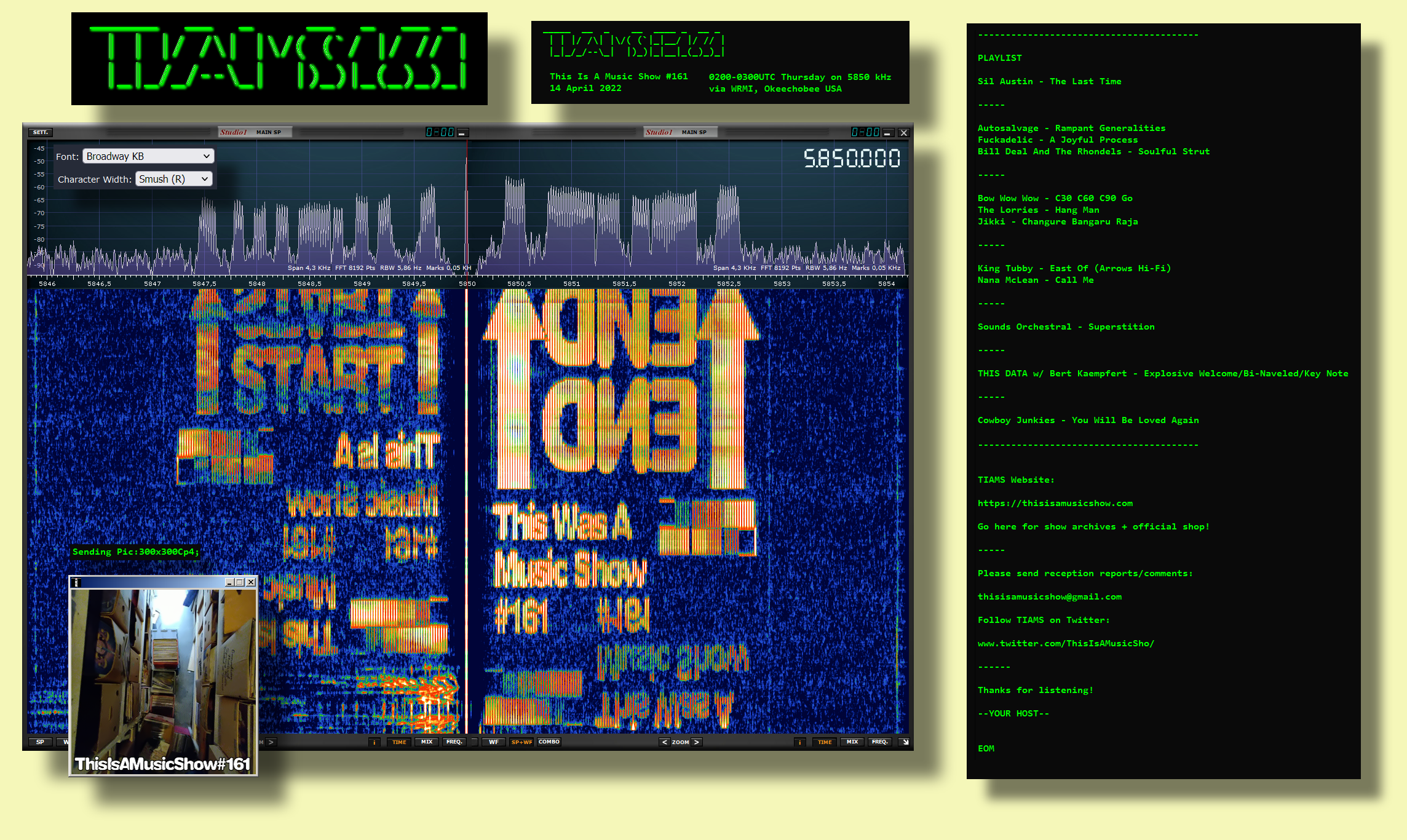
RSID: <<2022-04-14T02:46Z MFSK-64 @ 5850000+1500>>
This Is A Music Show #161
14 April 2022
0200-0300UTC Thursday on 5850 kHz
via WRMI, Okeechobee USA
***ALSO***
TIAnExpressMS w/ Radio Northern Europe International
via Channel 292 in Germany, mainly on 6070 kHz.
Broadcast various dates/times/freqs. Check the schedule here:
https://www.channel292.de/
https://rnei.org/
----------------------------------------
PLAYLIST
Sil Austin - The Last Time
-----
Autosalvage - Rampant Generalities
Fuckadelic - A Joyful Process
Bill Deal And The Rhondels - Soulful Strut
-----
Bow Wow Wow - C30 C60 C90 Go
The Lorries - Hang Man
Jikki - Changure Bangaru Raja
-----
King Tubby - East Of (Arrows Hi-Fi)
Nana McLean - Call Me
-----
Sounds Orchestral - Superstition
-----
THIS DATA w/ Bert Kaempfert - Explosive Welcome/Bi-Naveled/Key Note
-----
Cowboy Junkies - You Will Be Loved Again
----------------------------------------
TIAMS Website:
https://thisisamusicshow.com
Go here for show archives + official shop!
-----
Please send reception reports/comments:
thisisamusicshow@gmail.com
Follow TIAMS on Twitter:
www.twitter.com/ThisIsAMusicSho/
------
Thanks for listening!
--YOUR HOST--
EOM
RSID: <<2022-04-14T02:47Z
MFSK-64 @
5850000+1500>>
Sending Pic:300x300C;
